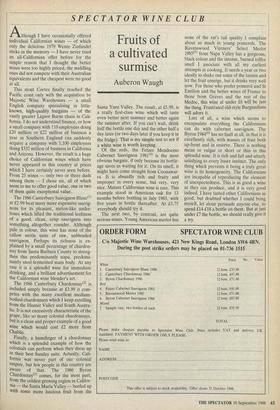SPECTATOR WINE CLUB
Fruits of a cultivated surmise
Auberon Waugh
Although I have occasionally offered individual Californian wines — of which only the delicibus 1979 Wente Zinfandel sticks in the memory — I have never tried an all-Californian offer before for the simple reason that I thought the better wines were too highly priced, the middling ones did not compete with their Australian equivalents and the cheapest were no good at all.
This stout Cortez finally reached the Pacific coast only with the acquisition by Majestic Wine Warehouses — a small English company specialising in little- known, high-quality bargains — of the vastly greater Liquor Barns chain in Cali- fornia. I do not understand finance, or how a small company with 110 employees doing £20 million or £22 million of business a year in Southern England can suddenly acquire a company with 1,100 employees doing $332 million of busihess in California and Arizona. However, the result is a huge choice of Californian wines which have never appeared in this country at prices which I have certainly never seen before. From 25 wines — only two or three duds among them — I chose six,, all of which seem to me to offer good value, one or two of them quite exceptional value.
The 1986 Canterbury Sauvignon Blanc()) at £2.99 beat many more expensive sauvig- nons for its pleasant, melon-like under- tones which lifted the traditional leafiness of a good, clean, . crisp sauvignon into something altogether rounder. Although pale in colour, this wine has none of the callow nettle taste of raw, unblended sauvignon. Perhaps its richness is ex- Olained by' a small percentage of chardon- nay from Santa Barbara County to streng- then this predominantly napa, predomi- nantly steel-fermented main body. At any rate it is a splendid wine for immediate drinking, and a brilliant advertisement for the Californian wine blender's art.
The 1986 Canterbury Chardonnay(2) is included simply because at £3.99 it com- petes with the many excellent medium- bodied chardonnays which I keep extolling from the Hunter Valley and South Austra- lia. It is not excessively characteristic of the grape, like so many colonial chardonnays, but is a clean and proper example of a good wine which would cost £2 more from Chablis.
Finally, a humdinger of a chardonnay which is a splendid example of how the colonials can perform when they dress up in their best Sunday suits. Actually, Cali- fornia was never part of our colonial empire, but few people in this country are aware of that. The 1986 Byron Chardonnay(3) comes, for the most part, from the coldest growing region in Califor- nia — the Santa Maria Valley — beefed up with some more luscious fruit from the Santa Ynez Valley. The result, at £5.99, is a really first-class wine which will taste even better next summer and better again the summer after. If you can't wait, drink half the bottle one day and the other half a day later (or two days later if you keep it in the fridge). That is my simple test to see if a white wine is worth keeping.
Of the reds, the Fetzer Mendocino Cabernet Sauvignon 1981(4) is the most obvious bargain, if only because its bottle- age saves us waiting for it. On its smell, it might have come straight from Coonawar- ra. It is absurdly rich and fruity and improper in every sense, but very, very nice. Mature Californian wine is rare. This example stood in American oak for 13 months before bottling in July 1983,. with five years in bottle thereafter. At £3.75 everybody should try it.
The next two, by contrast, are quite serious wines. Young American merlot has none of the rat's tail quality I complain about so much in young pomerols. The Ravenswood Vintners' Select Merlot 1985(5) from Napa Valley has a gorgeous, black colour and the intense, burned toffee smell I associate with all my earliest attempts at cooking. It needs a year or two ideally to shake out some of the tannin and let the fruit emerge, but it drinks very well now. For those who prefer pomerol and St Emilion and the better wines of France to those from Graves and the rest of the Medoc, this wine at under £6 will be just the thing. Frustrated old-style Burgundians will adore it.
Last of all, a wine which seems to encapsulate everything the Californians can do with cabernet sauvignon. The Byron 1984(6) has no fault at all, in that it is excellently rich, with masses of fruit both up-front and in reserve. There is nothing mean or vulgar or short or thin in this splendid wine. It is rich and full and utterly satisfying to every baser instinct. The only thing which prevents it being a truly great wine is its homogeneity. The Californians are incapable of reproducing the element of unexpectedness. This is as good a wine as they can produce, and it is very good indeed. I have tasted other Californians as good, but doubted whether I could bring myself, let alone persuade anyone else, to spend £14418 a bottle on them. But at just under £7 the bottle, we should really give it a try.






















































 Previous page
Previous page